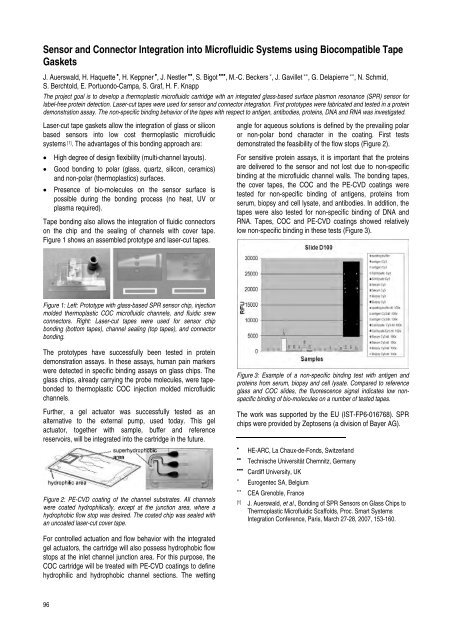research activities in 2007 - CSEM
research activities in 2007 - CSEM
research activities in 2007 - CSEM
Create successful ePaper yourself
Turn your PDF publications into a flip-book with our unique Google optimized e-Paper software.
Sensor and Connector Integration <strong>in</strong>to Microfluidic Systems us<strong>in</strong>g Biocompatible Tape<br />
Gaskets<br />
J. Auerswald, H. Haquette • , H. Keppner • , J. Nestler •• , S. Bigot ••• , M.-C. Beckers ∗ , J. Gavillet ∗∗ , G. Delapierre ∗∗ , N. Schmid,<br />
S. Berchtold, E. Portuondo-Campa, S. Graf, H. F. Knapp<br />
The project goal is to develop a thermoplastic microfluidic cartridge with an <strong>in</strong>tegrated glass-based surface plasmon resonance (SPR) sensor for<br />
label-free prote<strong>in</strong> detection. Laser-cut tapes were used for sensor and connector <strong>in</strong>tegration. First prototypes were fabricated and tested <strong>in</strong> a prote<strong>in</strong><br />
demonstration assay. The non-specific b<strong>in</strong>d<strong>in</strong>g behavior of the tapes with respect to antigen, antibodies, prote<strong>in</strong>s, DNA and RNA was <strong>in</strong>vestigated.<br />
Laser-cut tape gaskets allow the <strong>in</strong>tegration of glass or silicon<br />
based sensors <strong>in</strong>to low cost thermoplastic microfluidic<br />
systems [1] . The advantages of this bond<strong>in</strong>g approach are:<br />
• High degree of design flexibility (multi-channel layouts).<br />
• Good bond<strong>in</strong>g to polar (glass, quartz, silicon, ceramics)<br />
and non-polar (thermoplastics) surfaces.<br />
• Presence of bio-molecules on the sensor surface is<br />
possible dur<strong>in</strong>g the bond<strong>in</strong>g process (no heat, UV or<br />
plasma required).<br />
Tape bond<strong>in</strong>g also allows the <strong>in</strong>tegration of fluidic connectors<br />
on the chip and the seal<strong>in</strong>g of channels with cover tape.<br />
Figure 1 shows an assembled prototype and laser-cut tapes.<br />
Figure 1: Left: Prototype with glass-based SPR sensor chip, <strong>in</strong>jection<br />
molded thermoplastic COC microfluidic channels, and fluidic srew<br />
connectors. Right: Laser-cut tapes were used for sensor chip<br />
bond<strong>in</strong>g (bottom tapes), channel seal<strong>in</strong>g (top tapes), and connector<br />
bond<strong>in</strong>g.<br />
The prototypes have successfully been tested <strong>in</strong> prote<strong>in</strong><br />
demonstration assays. In these assays, human pa<strong>in</strong> markers<br />
were detected <strong>in</strong> specific b<strong>in</strong>d<strong>in</strong>g assays on glass chips. The<br />
glass chips, already carry<strong>in</strong>g the probe molecules, were tapebonded<br />
to thermoplastic COC <strong>in</strong>jection molded microfluidic<br />
channels.<br />
Further, a gel actuator was successfully tested as an<br />
alternative to the external pump, used today. This gel<br />
actuator, together with sample, buffer and reference<br />
reservoirs, will be <strong>in</strong>tegrated <strong>in</strong>to the cartridge <strong>in</strong> the future.<br />
Figure 2: PE-CVD coat<strong>in</strong>g of the channel substrates. All channels<br />
were coated hydrophilically, except at the junction area, where a<br />
hydrophobic flow stop was desired. The coated chip was sealed with<br />
an uncoated laser-cut cover tape.<br />
For controlled actuation and flow behavior with the <strong>in</strong>tegrated<br />
gel actuators, the cartridge will also possess hydrophobic flow<br />
stops at the <strong>in</strong>let channel junction area. For this purpose, the<br />
COC cartridge will be treated with PE-CVD coat<strong>in</strong>gs to def<strong>in</strong>e<br />
hydrophilic and hydrophobic channel sections. The wett<strong>in</strong>g<br />
96<br />
angle for aqueous solutions is def<strong>in</strong>ed by the prevail<strong>in</strong>g polar<br />
or non-polar bond character <strong>in</strong> the coat<strong>in</strong>g. First tests<br />
demonstrated the feasibility of the flow stops (Figure 2).<br />
For sensitive prote<strong>in</strong> assays, it is important that the prote<strong>in</strong>s<br />
are delivered to the sensor and not lost due to non-specific<br />
b<strong>in</strong>d<strong>in</strong>g at the microfluidic channel walls. The bond<strong>in</strong>g tapes,<br />
the cover tapes, the COC and the PE-CVD coat<strong>in</strong>gs were<br />
tested for non-specific b<strong>in</strong>d<strong>in</strong>g of antigens, prote<strong>in</strong>s from<br />
serum, biopsy and cell lysate, and antibodies. In addition, the<br />
tapes were also tested for non-specific b<strong>in</strong>d<strong>in</strong>g of DNA and<br />
RNA. Tapes, COC and PE-CVD coat<strong>in</strong>gs showed relatively<br />
low non-specific b<strong>in</strong>d<strong>in</strong>g <strong>in</strong> these tests (Figure 3).<br />
Figure 3: Example of a non-specific b<strong>in</strong>d<strong>in</strong>g test with antigen and<br />
prote<strong>in</strong>s from serum, biopsy and cell lysate. Compared to reference<br />
glass and COC slides, the fluorescence signal <strong>in</strong>dicates low nonspecific<br />
b<strong>in</strong>d<strong>in</strong>g of bio-molecules on a number of tested tapes.<br />
The work was supported by the EU (IST-FP6-016768). SPR<br />
chips were provided by Zeptosens (a division of Bayer AG).<br />
•<br />
HE-ARC, La Chaux-de-Fonds, Switzerland<br />
••<br />
Technische Universität Chemnitz, Germany<br />
•••<br />
Cardiff University, UK<br />
∗<br />
Eurogentec SA, Belgium<br />
∗∗<br />
CEA Grenoble, France<br />
[1] J. Auerswald, et al., Bond<strong>in</strong>g of SPR Sensors on Glass Chips to<br />
Thermoplastic Microfluidic Scaffolds, Proc. Smart Systems<br />
Integration Conference, Paris, March 27-28, <strong>2007</strong>, 153-160.








